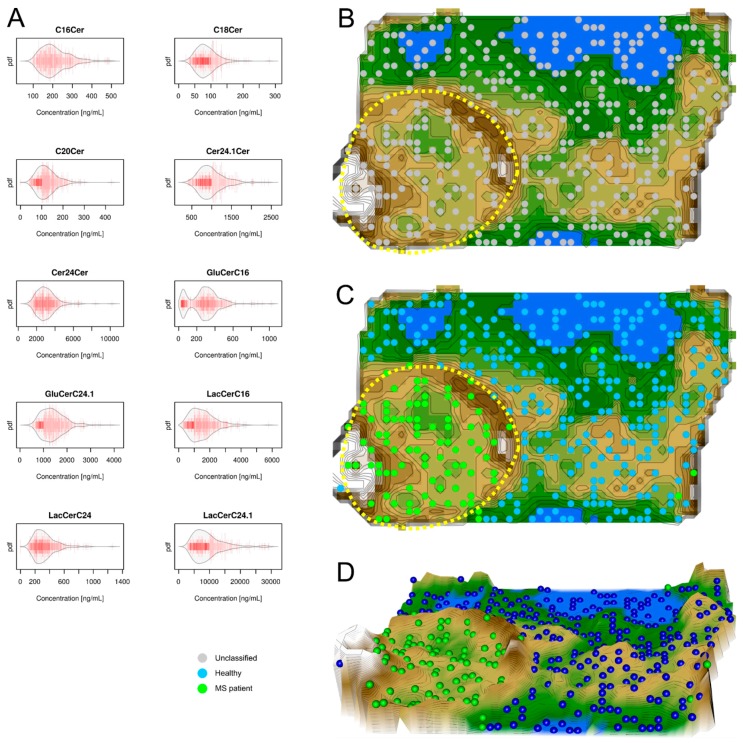Figure 3.
Data structures of ceramide serum concentrations: Left part, (A) Serum concentrations of d = 10 ceramides (raw data, complete cohort). The data are shown in alphabetical order of lipid mediator names. The beanplots [13] show the individual observations as small lines in a one-dimensional scatter plot, surrounded by a mirrored kernel density estimation of the distributions. Cer = ceramide, GluCer = glucosylceramide, LacCer = lactosylceramide. Right part, U*-matrix visualization of the distance and density based structures of the ceramide serum concentrations (d = 10 ceramide markers) observed in n = 102 multiple sclerosis patients and n = 301 healthy subjects. The figure has been obtained using a projection of the data points onto a toroid grid of 1440 neurons where the opposite edges are connected. The U*-matrix was colored as a geographical map with brown heights and green valleys with blue lakes. Valleys indicate clusters and watersheds indicate borderlines between different clusters. The dots indicate the so-called “best matching units” (BMUs) of the self-organizing map (SOM), which are those neurons whose weight vector is most similar to the input. A single neuron can be the BMU for more than one data point or subject, hence, the number of BMUs may not be equal to the number of subjects as in the present case. Differently colored BMUs represent healthy versus MS patient groups; (B) projection of the markers shown in A onto a self-organizing map. On the raw U-matrix, the BMUs are colored neutrally. A cluster structure emerges as two separate clusters. One cluster region at the lower left part of the U*matrix is marked with a dotted yellow line; (C) analysis of agreement between the data structure and grouping of the cohort. When the group membership to either the MS patients (green dots) or the healthy subjects (blue dots) is projected onto the U*-matrix, it becomes clear that the separate cluster surrounded by the yellow dotted line contains only MS patients while the remaining cluster contains nearly only healthy subjects. This indicates an almost perfect separation of patients from healthy subjects by the ceramide serum concentrations (except a few outliers, i.e., green dots among the blue-dots zone); (D) a topographic map of the U-matrix visualization of distance and density based structures of the ceramide serum concentrations. The figure has been created using the R software package (version 3.3.2 for Linux; Available online: http://CRAN.R-project.org/ [14]). Specifically, the beanplots have been drawn using the R package “beanplot” (Kampstra P.; Available online: https://cran.r-project.org/package=beanplot [13]) and the figures displaying geographical map analogies have been created using our R library “Umatrix” (M. Thrun, F. Lerch, Marburg, Germany, Available online: http://www.uni-marburg.de/fb12/arbeitsgruppen/datenbionik//software; file, Available online: http://www.uni-marburg.de/fb12/arbeitsgruppen/datenbionik//umatrix.tar.gz).

